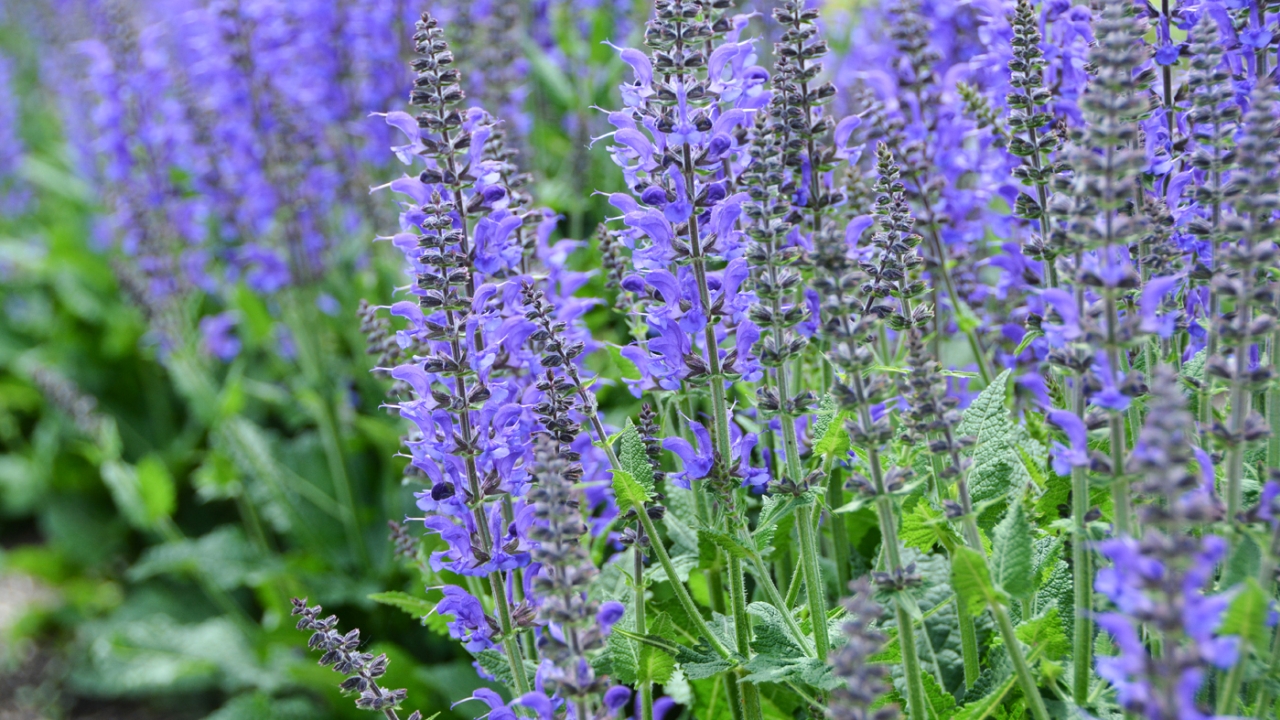

Plant Evaluation: A Comparative Trial of Hardy Salvia Cultivars
A Comparative Trial Of Hardy Salvia Cultivars | Issue 52 2025
Patrick Dahl, Plant Evaluator
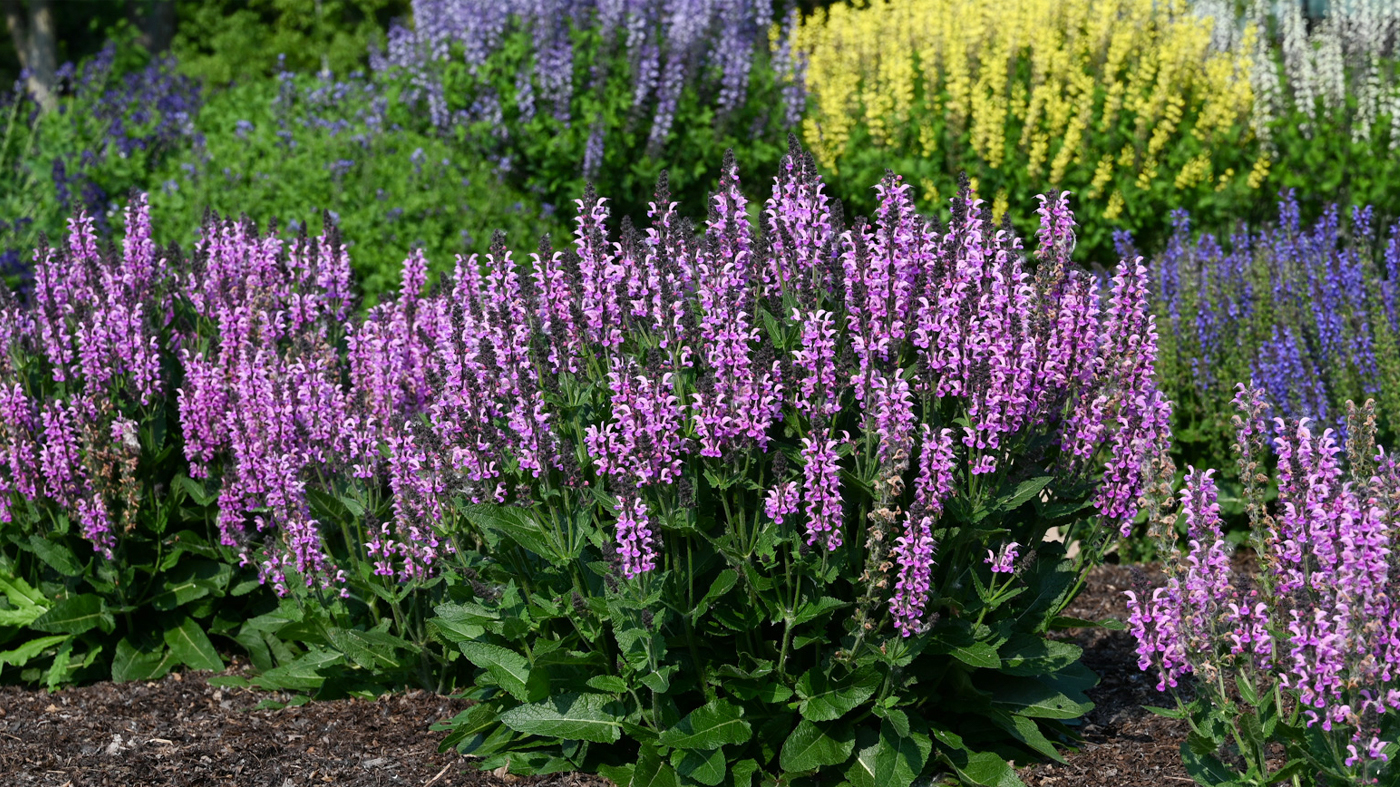
Salvia ‘Back to the Fuchsia’
Salvia is the largest genus in the mint family (Lamiaceae), and has a near-cosmopolitan distribution of annuals, perennials, and shrubs. After a 2017 publication by Drew et al., which folded in the genera Dorystaechas, Meriandra, Perovskia, Rosmarinus, and Zhumeria, Salvia now consists of more than 1,000 species. Many species and varieties of Salvia are cultivated and available to gardeners.
For gardeners in colder regions, cultivated varieties of the perennial species woodland sage (Salvia nemorosa) and meadow sage (S. pratensis), as well as hybrids based on these species, have become a staple of many gardens and landscapes. Salvia ×sylvestris may also be used to refer to a hybrid between S. nemorosa and S. pratensis. This name is used inconsistently in commercial contexts and may be absent even when its usage would be appropriate.
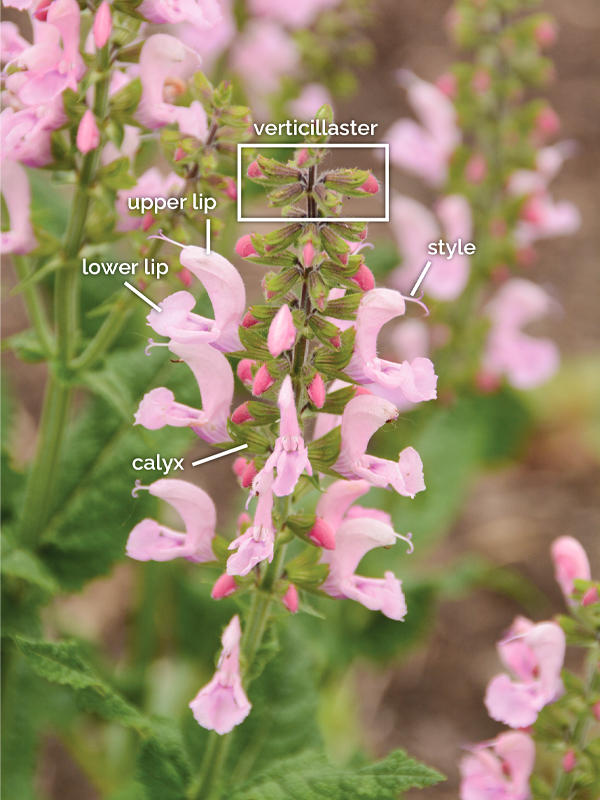
Figure 1. Floral structure of Salvia 'Ballerina Pink'
These hardy salvias are clump-forming, have square stems, and have rough-textured, aromatic foliage. They produce tubular flowers with an upper and lower lip: the upper lip is claw- or crescent-shaped while the lower lip is wider and lobed (see Figure 1).
Flowers are arranged in a special configuration called a verticillaster, which consists of opposite groupings of flowers that are closely spaced so they appear to encircle the central stalk. Salvia pratensis tends to have larger flowers and coarser foliage than S. nemorosa. These differences between the two species are exploited by breeders to develop numerous different combinations of leaf and flower size.
Hardy salvias are generally easy to grow with good drainage. Sustained excessive moisture levels can promote root rot, which is a bacterial or fungal infection that favors anaerobic conditions. Other types of infections have also been observed in hardy salvias, but few are considered a major concern to gardeners. Pressure from deer, rabbits, and other pests is generally not reported to be an issue, which is usually attributed to the aromatic nature of their leaves.
List of Sections
The Evaluation Report
Top-Rated Hardy Salvias
Top-Rated Hardy Salvias
Observations and Discussion
Summary
References
Clebsch, Betsy. 1997. A Book of Salvias: Sages for Every Garden. 1st ed. Portland, OR: Timber Press, Inc.
Drew et al. 2004. “Salvia united: The greatest good for the greatest number.” Taxon 66, no. 1: 133-145. doi.org/10.12705/661.7.
Hawke, Richard. 2000. “A Performance Appraisal of the Hardy Sages.” Plant Evaluation Notes, no. 14.
Hawke, Richard. 2019. “An Evaluation Study of Tender Salvias (Salvia spp.).” Plant Evaluation Notes, no. 44.
Hawke, Richard. 2016. “Salvia’s That Won’t Let You Down.” Fine Gardening, no. 169.
Sutton, John. 1999. The Gardener’s Guide to Growing Salvias. 1st ed. Portland, OR: Timber Press Inc.
Whittlesey, John. 2014. The Plant Lover’s Guide to Salvias. 1st ed. Portland, OR: Timber Press, Inc.
Special thanks to all the plant evaluators and photographers who contributed to this report: Alex Almodovar, Janice Becker, Samantha Danguilan, Richard Hawke, Nat Kahn, Heidi Petersen, Robert Witkowski, and Gavin Young.
Front Cover: Salvia nemorosa ‘Indiglo Girl’
-
From 2014 through 2023, The Chicago Botanic Garden (USDA Hardiness Zone 5b-6a, AHS Plant Heat Zone 5) evaluated 49 cultivars of Salvia nemorosa or related hybrids. Each cultivar was planted in a row of five plants and data was collected on overall health and habit of the variety, any disease or pest issues, winter hardiness, floral production, and other ornamental considerations or notable morphological characteristics. All cultivars with surviving plants were kept in the trial for a minimum of four years.
The first year was considered an establishment year, and data taken during that period was for monitoring purposes only and did not affect the final rating of each cultivar (see Table 2 for the years each individual cultivar was trialed).
The trial garden has a clay-loam soil with a pH of 7.4. During the trial period, plants were exposed to wind in all directions and up to 10 hours of full sun during the growing season. Maintenance practices were kept to a minimum, thereby allowing the plants to thrive or fail under natural conditions. Trial beds were irrigated via overhead sprinklers when necessary, mulched with composted leaves once each growing season, and weeded regularly. Plants were not deadheaded, fertilized, mulched for winter, or treated for insects or diseases.
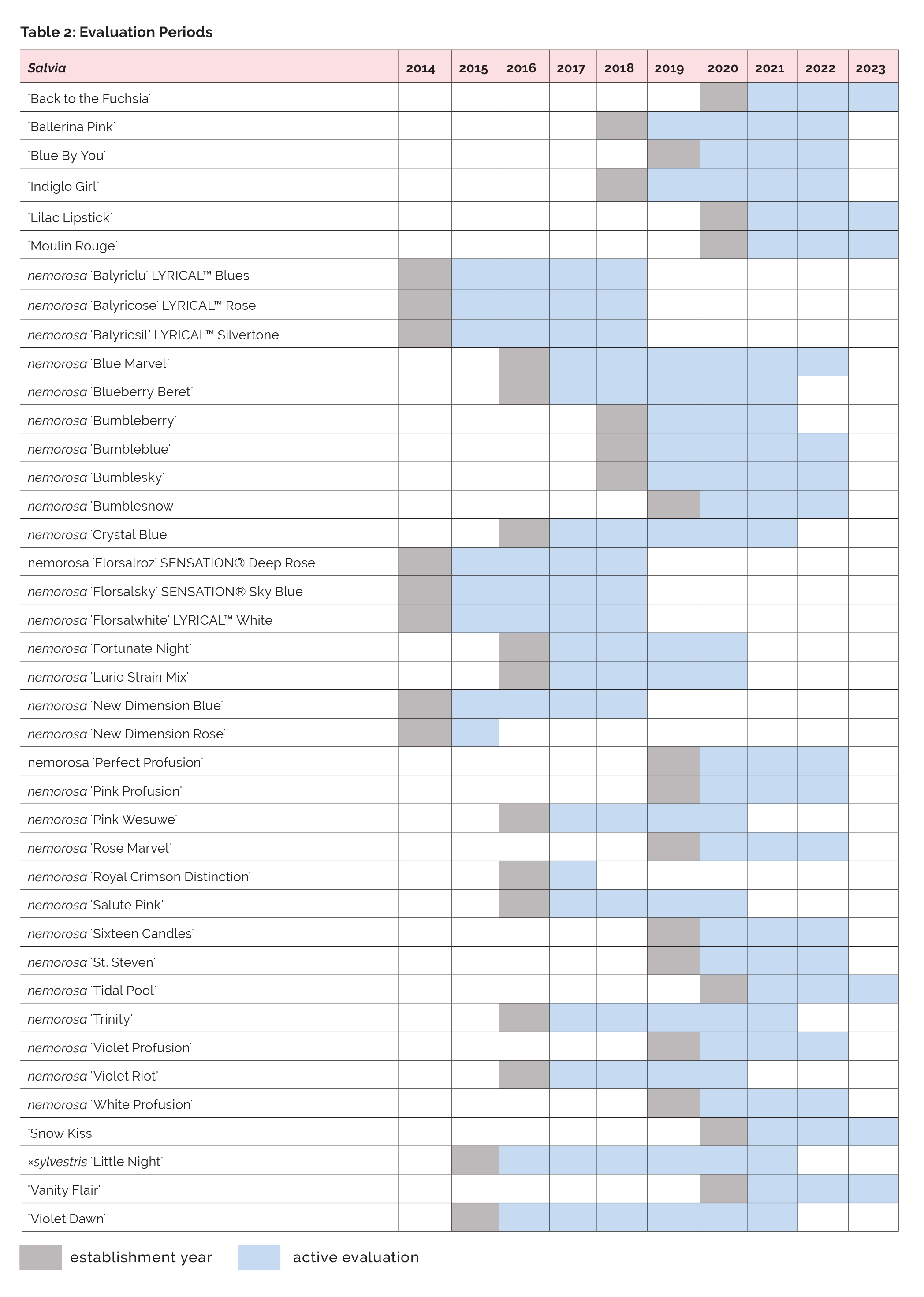
Table 2: Evaluation Periods
From 2014 through 2023, The Chicago Botanic Garden (USDA Hardiness Zone 5b-6a, AHS Plant Heat Zone 5) evaluated 49 cultivars of Salvia nemorosa or related hybrids. Each cultivar was planted in a row of five plants and data was collected on overall health and habit of the variety, any disease or pest issues, winter hardiness, floral production, and other ornamental considerations or notable morphological characteristics. All cultivars with surviving plants were kept in the trial for a minimum of four years.
The first year was considered an establishment year, and data taken during that period was for monitoring purposes only and did not affect the final rating of each cultivar (see Table 2 for the years each individual cultivar was trialed).
The trial garden has a clay-loam soil with a pH of 7.4. During the trial period, plants were exposed to wind in all directions and up to 10 hours of full sun during the growing season. Maintenance practices were kept to a minimum, thereby allowing the plants to thrive or fail under natural conditions. Trial beds were irrigated via overhead sprinklers when necessary, mulched with composted leaves once each growing season, and weeded regularly. Plants were not deadheaded, fertilized, mulched for winter, or treated for insects or diseases.

Table 2: Evaluation Periods
-
Table 1 shows morphological and phenological data, as well as overall ratings for 40 of the 49 Salvia cultivars in the trial. Overall ratings were based on average health, habit quality, and floral production, with an emphasis on the latter. While data was collected on pest and disease pressure, neither was noted to be a significant issue in the trial, so the data was ultimately not factored into the overall ratings. Cultivars that lost plants during the winter received a penalty to their overall score.
Salvia nemorosa ‘Lurie Strain Mix’ is a seed strain introduced by Intrinsic Perennials in Hebron, Illinois. The mix is based on a seedling selected by Piet Oudolf and Roy Diblik in the Lurie Garden in Millennium Park, Chicago, Illinois. As a seed strain, various plant sizes, flower colors, and flower sizes were observed on the five plants in the trial. Due to these variations, the data in Table 1 for ‘Lurie Strain Mix’ does not include morphological data and is limited to bloom timing and flower coverage.
Nine of the original 49 cultivars in the trial were lost after only one year due to an extreme flood event, where the bed remained waterlogged for a significant amount of time. These taxa were not re-trialed, did not receive ratings, and are not included in Table 1 The cultivars lost to flooding were 'Burgundy Candles', Sensation® Compact Bright Rose ['Florsalbro'], Sensation® Compact White [‘Florsalcwh’], Sensation® Deep Blue [‘Florsaldblu’], Sensation® Medium Deep Rose [‘Florsaldro’], Sensation® Medium Light Pink [‘Florsaliro’], Sensation® Medium White [‘Florsalmwh’], Sensation® Medium Pink [‘Florsalpi’], and Sensation® Medium Purple [‘Florsalpur’].
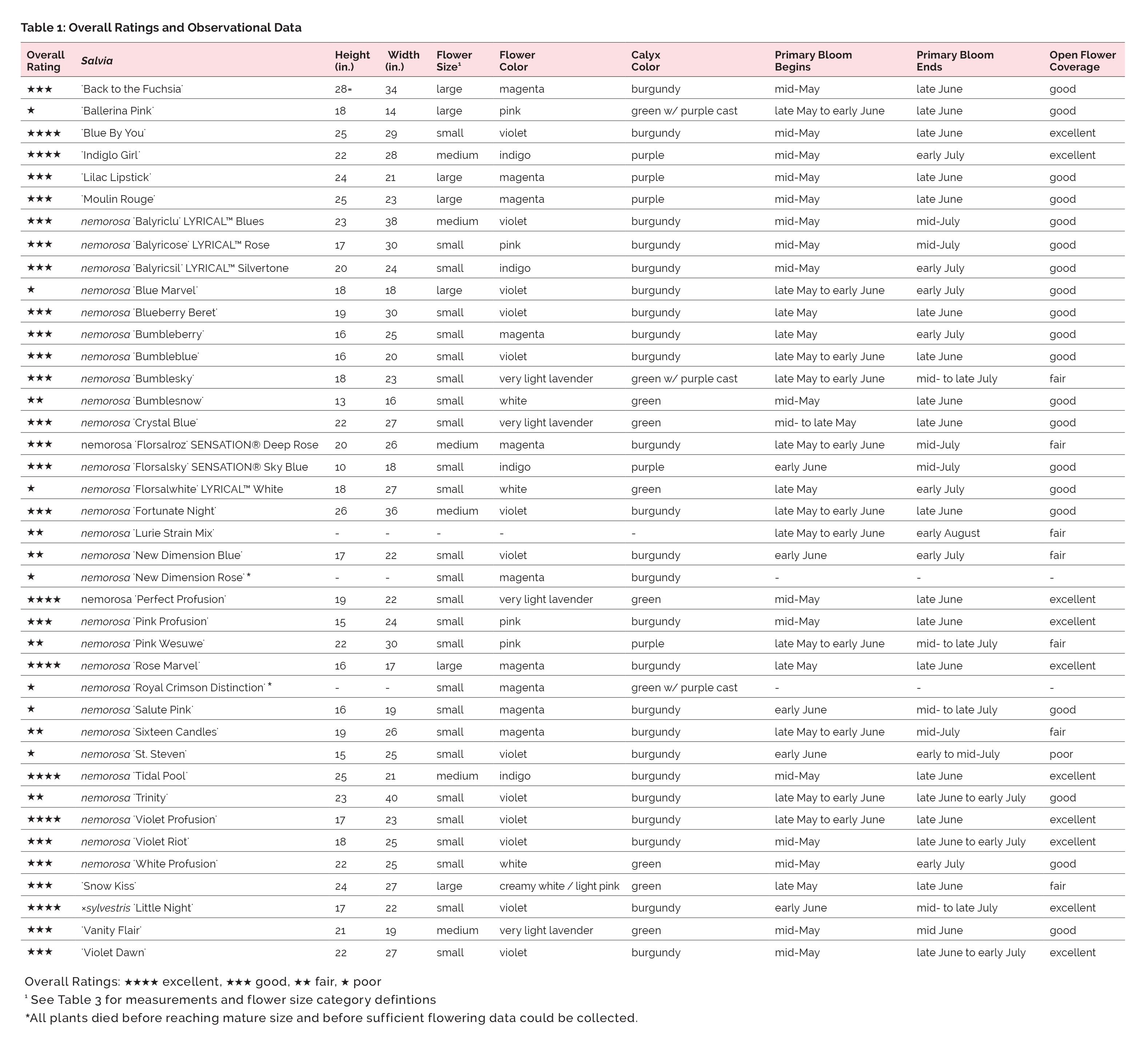
Table 1: Overall Ratings and Observational Data
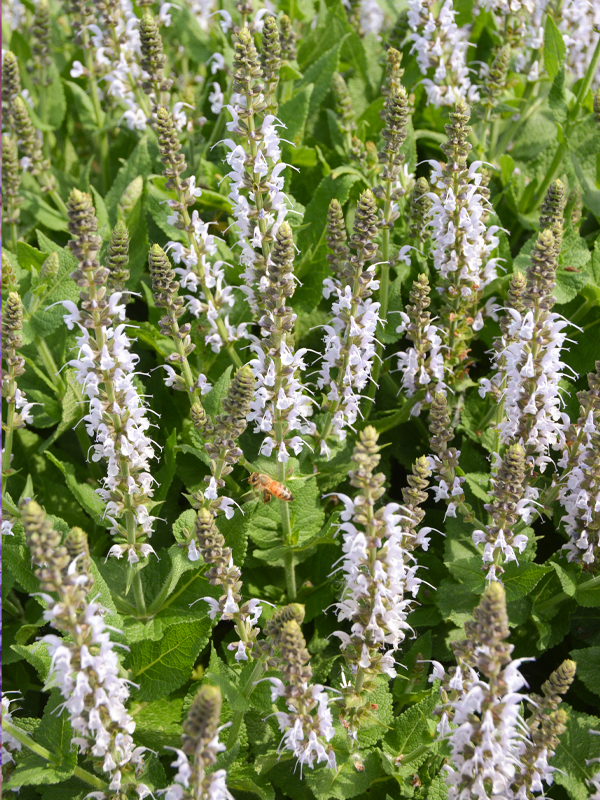
Salvia nemorosa 'Bumblesky’
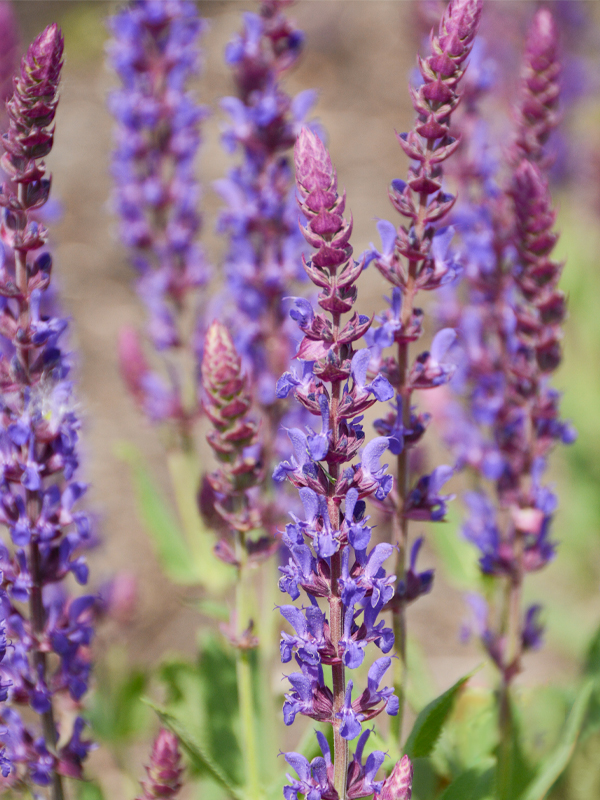
Salvia nemorosa 'Burgundy Candles’
Table 1 shows morphological and phenological data, as well as overall ratings for 40 of the 49 Salvia cultivars in the trial. Overall ratings were based on average health, habit quality, and floral production, with an emphasis on the latter. While data was collected on pest and disease pressure, neither was noted to be a significant issue in the trial, so the data was ultimately not factored into the overall ratings. Cultivars that lost plants during the winter received a penalty to their overall score.
Salvia nemorosa ‘Lurie Strain Mix’ is a seed strain introduced by Intrinsic Perennials in Hebron, Illinois. The mix is based on a seedling selected by Piet Oudolf and Roy Diblik in the Lurie Garden in Millennium Park, Chicago, Illinois. As a seed strain, various plant sizes, flower colors, and flower sizes were observed on the five plants in the trial. Due to these variations, the data in Table 1 for ‘Lurie Strain Mix’ does not include morphological data and is limited to bloom timing and flower coverage.
Nine of the original 49 cultivars in the trial were lost after only one year due to an extreme flood event, where the bed remained waterlogged for a significant amount of time. These taxa were not re-trialed, did not receive ratings, and are not included in Table 1 The cultivars lost to flooding were 'Burgundy Candles', Sensation® Compact Bright Rose ['Florsalbro'], Sensation® Compact White [‘Florsalcwh’], Sensation® Deep Blue [‘Florsaldblu’], Sensation® Medium Deep Rose [‘Florsaldro’], Sensation® Medium Light Pink [‘Florsaliro’], Sensation® Medium White [‘Florsalmwh’], Sensation® Medium Pink [‘Florsalpi’], and Sensation® Medium Purple [‘Florsalpur’].

Table 1: Overall Ratings and Observational Data

Salvia nemorosa 'Bumblesky’

Salvia nemorosa 'Burgundy Candles’
-
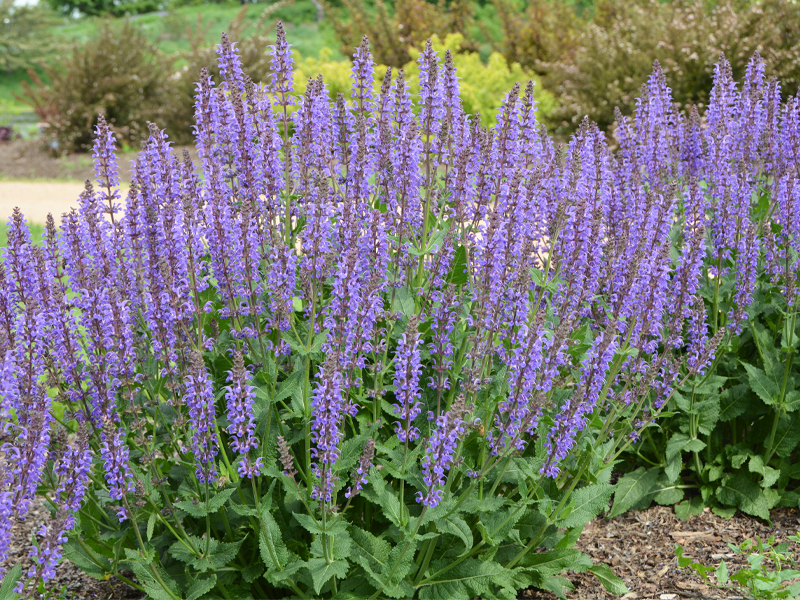
Salvia 'Blue By You'
‘Blue By You’
‘Blue By You’ was consistently noted for its robust, bushy habit, with the plants averaging 25 inches tall and 29 inches wide. Flowering typically began in late May with the primary flush fading by the end of June. The flowers were predominantly a cool, medium violet, but the style and base of each flower were white. The white was just visible enough to lighten the overall feel of the floral display. The flowers were set on inflorescences with peduncles and calyces that were a mix of green and burgundy, the aggregate of which read as bronze. The resulting combination was a full, well-balanced floral display with a distinct feeling of refinement.
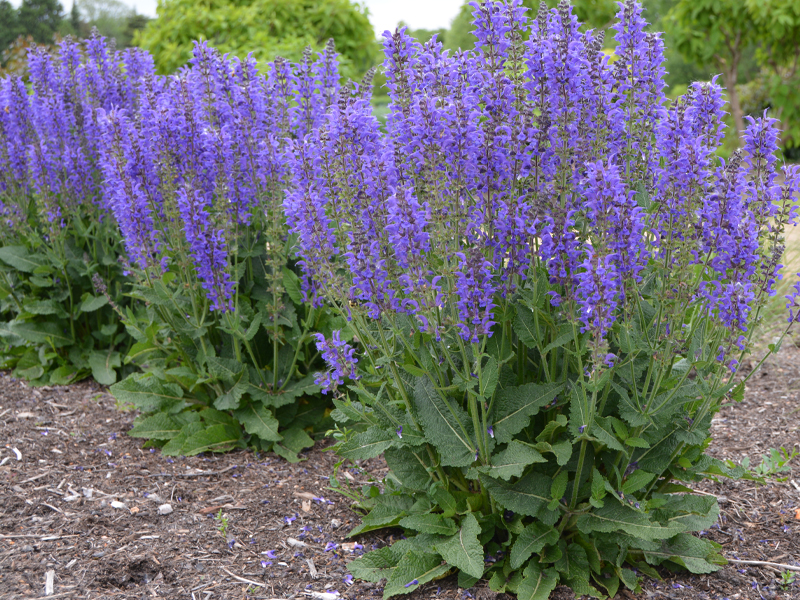
Salvia 'Indiglo Girl'
‘Indiglo Girl’
‘Indiglo Girl’ displayed superior flower production. At the very end of May—about a week later than many varieties—‘Indiglo Girl’ displayed medium-sized, indigo flowers with calyces that started near-black and faded to green. The primary bloom was mostly concluded by the beginning of July, but flowering continued in a modest display until the end of the month. The shape of ‘Indiglo Girl’ started as notably upright, but became more rounded as the seasons went on and the plants grew larger, eventually reaching an average size of 22 inches tall and 28 inches wide. The habit was consistently robust and did not open during or after flowering.
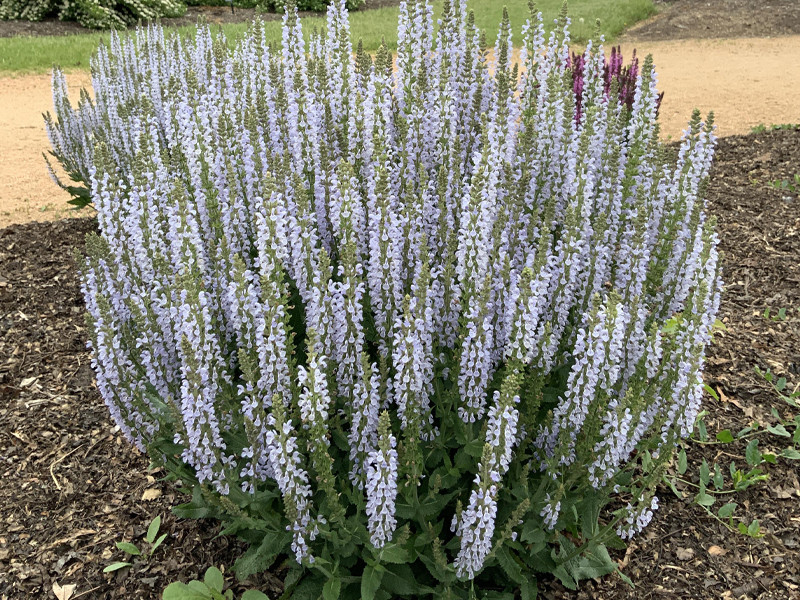
Salvia nemorosa 'Perfect Profusion'
‘Perfect Profusion’
Beginning in mid- to late May, ‘Perfect Profusion’ produced small offwhite flowers that only measured ⅛-inch wide. The flowers were given their cool feel by a minuscule amount of bluish-violet pigment in the lower lip and center of the flower. At the point of peak floral display—typically in mid-June—the habit of the plants was robust and exceptionally round, with the average plant measuring 19 inches tall and 22 inches wide. Densely packed flower spikes covered the plants almost all the way to the base. The lower spikes had to bend slightly around the widest part of the plant, which emphasized the round shape.
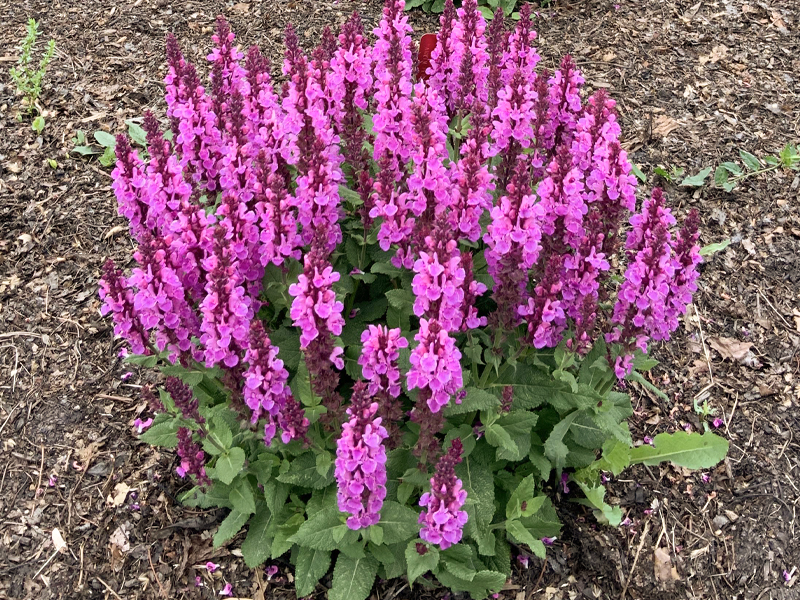
Salvia nemorosa 'Rose Marvel'
‘Rose Marvel’
‘Rose Marvel’ had a variable first bloom date, with the earliest recorded in mid-May and the latest in mid-June. The flowers were a rich combination of saturated pink petals with purplish-red calyces. The boldness of the floral display was heightened by the fact that the flowers were some of the largest in the trial, measuring ⅜-inch wide, while the overall plant size was relatively compact at 16 inches tall and 17 inches wide. ‘Rose Marvel’ was also consistently noted for exceptional plant-to-plant consistency and uniformity.
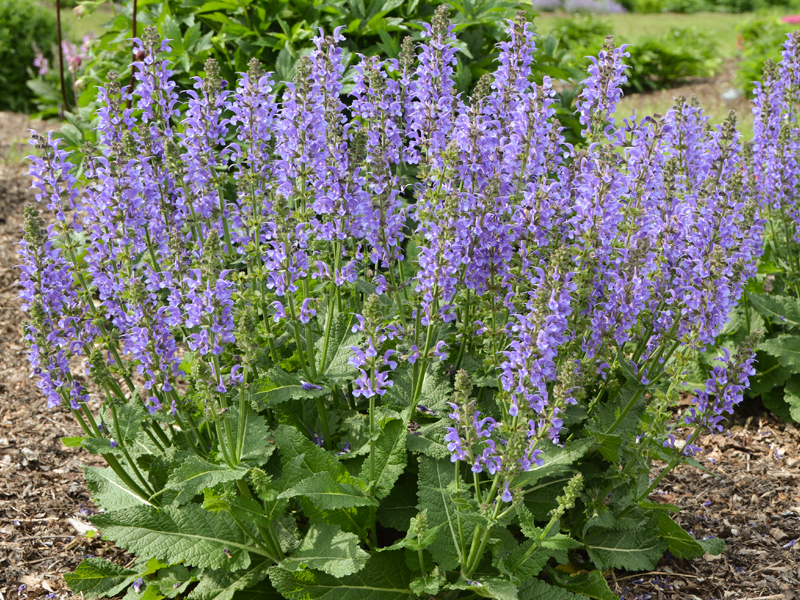
Salvia 'Tidal Pool'
‘Tidal Pool’
The floral display of ‘Tidal Pool’ had a similar overall tone to ‘Blue By You’; the styles were white with violet tips, the inner base of the tubular structure was white, and the overall hue of the flowers read as a medium-light indigo. The standout trait of ‘Tidal Pool’ was the fact that the upper and lower lips of the flowers were subtly different hues; the upper lip was ever so slightly closer to a shade of violet whereas the lobes of the lower lip were a bluer tone. The calyces were a base green color with streaks of bronze. While the flowers were relatively large at ¼-inches wide by ¾-inches long, the variation in color of the flowers and calyces caused the overall look to be more textured than bold. ‘Tidal Pool’ consistently displayed a superior, robust habit, and on average measured 25 inches tall and 21 inches wide.
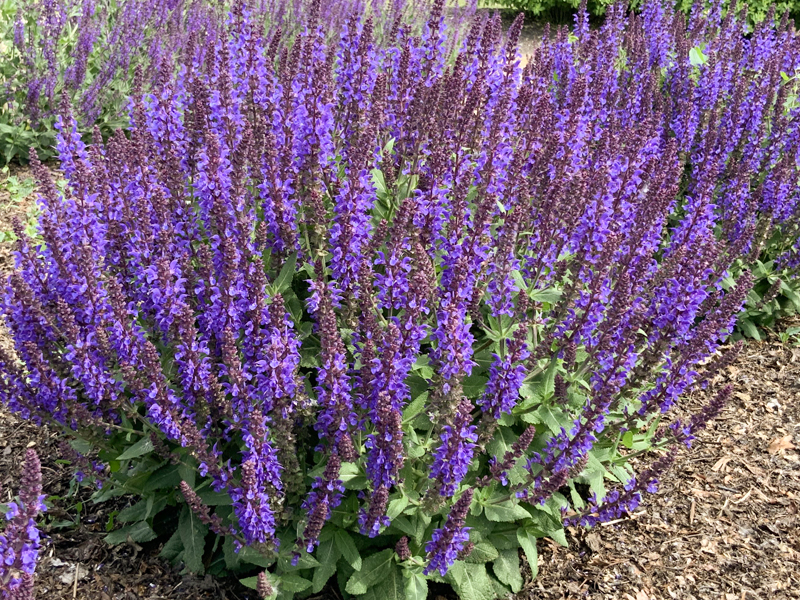
Salvia 'Violet Profusion'
‘Violet Profusion’
‘Violet Profusion’ flowered primarily from late May to late June and produced inflorescences of small violet flowers. The calyces started off burgundy-colored but eventually faded to green by the end of the bloom period. Like ‘Perfect Profusion’, the habits were quite full and robust, and flowers were produced nearly to the base of the plant. The average plant measured 19 inches tall by 23 inches wide.
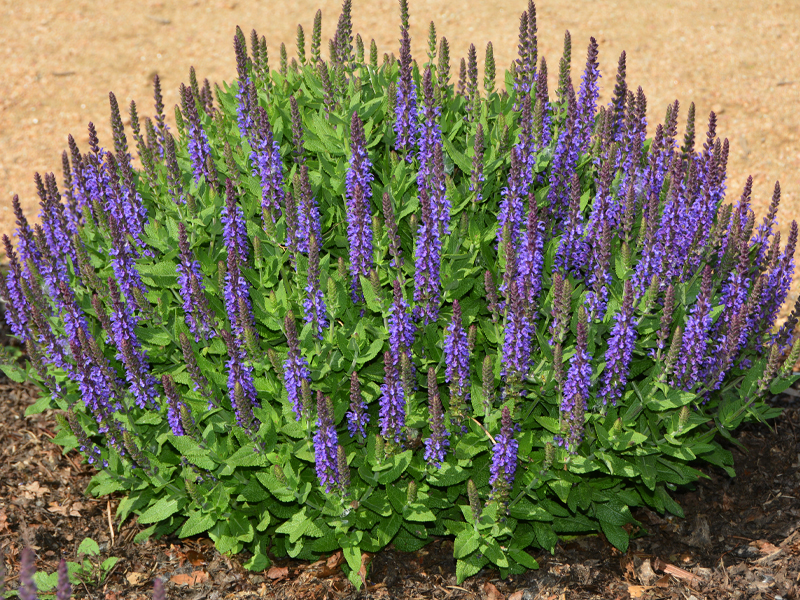
Salvia ×sylvestris 'Little Night'
‘Little Night’
‘Little Night’ started flowering during the first or second week of June, which is later than almost half of the cultivars in the trial. The flowers were violet with small white markings near the center. While the flowers were not quite indigo, the markings gave the flowers a cooler and lighter look than other violet-flowered cultivars. The evolution of the appearance of these plants during the bloom period was more significant than most. The height of the plants was quite short when flowering began in the spring and the calyces had a slight burgundy or bronze cast. While development continued, the color of the calyces changed to a stronger burgundy, causing the overall impression of the floral display to become darker. Eventually measuring around 5 inches long, the inflorescences of ‘Little Night’ accounted for enough of the height of each plant such that as they elongated, the plants looked to be gaining height quite rapidly. ‘Little Night’ was also notable for its exceptionally dense full look, which was partly due to its overall compact size at 17 inches tall by 22 inches wide, but was also due to its small, densely packed folia

Salvia 'Blue By You'
‘Blue By You’
‘Blue By You’ was consistently noted for its robust, bushy habit, with the plants averaging 25 inches tall and 29 inches wide. Flowering typically began in late May with the primary flush fading by the end of June. The flowers were predominantly a cool, medium violet, but the style and base of each flower were white. The white was just visible enough to lighten the overall feel of the floral display. The flowers were set on inflorescences with peduncles and calyces that were a mix of green and burgundy, the aggregate of which read as bronze. The resulting combination was a full, well-balanced floral display with a distinct feeling of refinement.

Salvia 'Indiglo Girl'
‘Indiglo Girl’
‘Indiglo Girl’ displayed superior flower production. At the very end of May—about a week later than many varieties—‘Indiglo Girl’ displayed medium-sized, indigo flowers with calyces that started near-black and faded to green. The primary bloom was mostly concluded by the beginning of July, but flowering continued in a modest display until the end of the month. The shape of ‘Indiglo Girl’ started as notably upright, but became more rounded as the seasons went on and the plants grew larger, eventually reaching an average size of 22 inches tall and 28 inches wide. The habit was consistently robust and did not open during or after flowering.

Salvia nemorosa 'Perfect Profusion'
‘Perfect Profusion’
Beginning in mid- to late May, ‘Perfect Profusion’ produced small offwhite flowers that only measured ⅛-inch wide. The flowers were given their cool feel by a minuscule amount of bluish-violet pigment in the lower lip and center of the flower. At the point of peak floral display—typically in mid-June—the habit of the plants was robust and exceptionally round, with the average plant measuring 19 inches tall and 22 inches wide. Densely packed flower spikes covered the plants almost all the way to the base. The lower spikes had to bend slightly around the widest part of the plant, which emphasized the round shape.

Salvia nemorosa 'Rose Marvel'
‘Rose Marvel’
‘Rose Marvel’ had a variable first bloom date, with the earliest recorded in mid-May and the latest in mid-June. The flowers were a rich combination of saturated pink petals with purplish-red calyces. The boldness of the floral display was heightened by the fact that the flowers were some of the largest in the trial, measuring ⅜-inch wide, while the overall plant size was relatively compact at 16 inches tall and 17 inches wide. ‘Rose Marvel’ was also consistently noted for exceptional plant-to-plant consistency and uniformity.

Salvia 'Tidal Pool'
‘Tidal Pool’
The floral display of ‘Tidal Pool’ had a similar overall tone to ‘Blue By You’; the styles were white with violet tips, the inner base of the tubular structure was white, and the overall hue of the flowers read as a medium-light indigo. The standout trait of ‘Tidal Pool’ was the fact that the upper and lower lips of the flowers were subtly different hues; the upper lip was ever so slightly closer to a shade of violet whereas the lobes of the lower lip were a bluer tone. The calyces were a base green color with streaks of bronze. While the flowers were relatively large at ¼-inches wide by ¾-inches long, the variation in color of the flowers and calyces caused the overall look to be more textured than bold. ‘Tidal Pool’ consistently displayed a superior, robust habit, and on average measured 25 inches tall and 21 inches wide.

Salvia 'Violet Profusion'
‘Violet Profusion’
‘Violet Profusion’ flowered primarily from late May to late June and produced inflorescences of small violet flowers. The calyces started off burgundy-colored but eventually faded to green by the end of the bloom period. Like ‘Perfect Profusion’, the habits were quite full and robust, and flowers were produced nearly to the base of the plant. The average plant measured 19 inches tall by 23 inches wide.

Salvia ×sylvestris 'Little Night'
‘Little Night’
‘Little Night’ started flowering during the first or second week of June, which is later than almost half of the cultivars in the trial. The flowers were violet with small white markings near the center. While the flowers were not quite indigo, the markings gave the flowers a cooler and lighter look than other violet-flowered cultivars. The evolution of the appearance of these plants during the bloom period was more significant than most. The height of the plants was quite short when flowering began in the spring and the calyces had a slight burgundy or bronze cast. While development continued, the color of the calyces changed to a stronger burgundy, causing the overall impression of the floral display to become darker. Eventually measuring around 5 inches long, the inflorescences of ‘Little Night’ accounted for enough of the height of each plant such that as they elongated, the plants looked to be gaining height quite rapidly. ‘Little Night’ was also notable for its exceptionally dense full look, which was partly due to its overall compact size at 17 inches tall by 22 inches wide, but was also due to its small, densely packed folia
-
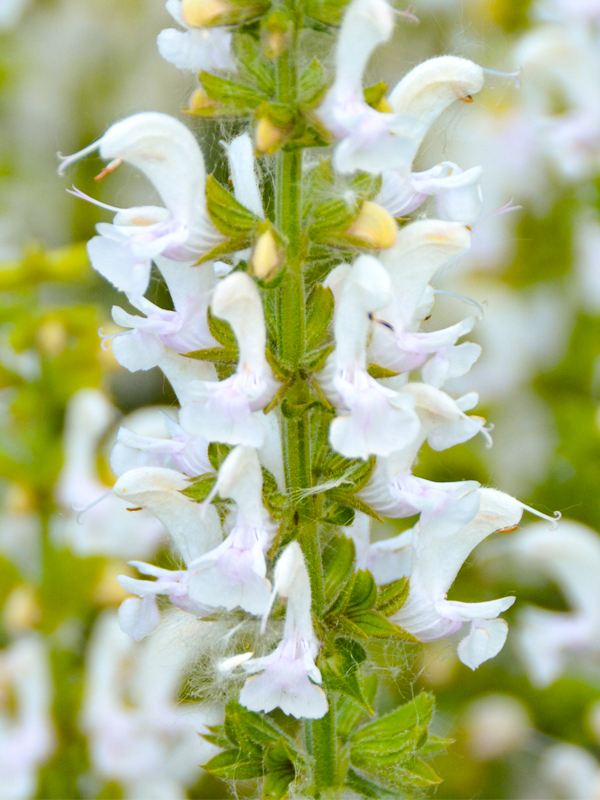
Flowers of Salvia 'Snow Kiss'
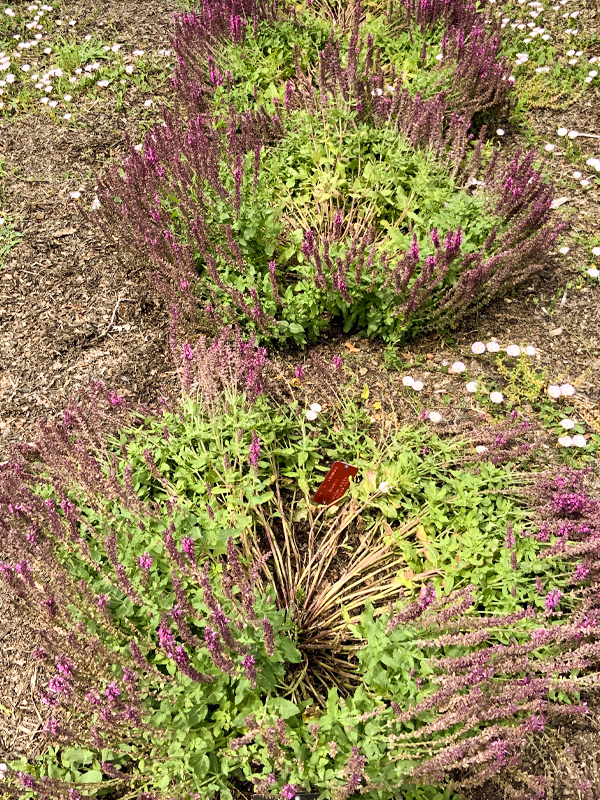
Open habits of Salvia nemorosa 'Sixteen Candles' exposing lighter inner foilage.
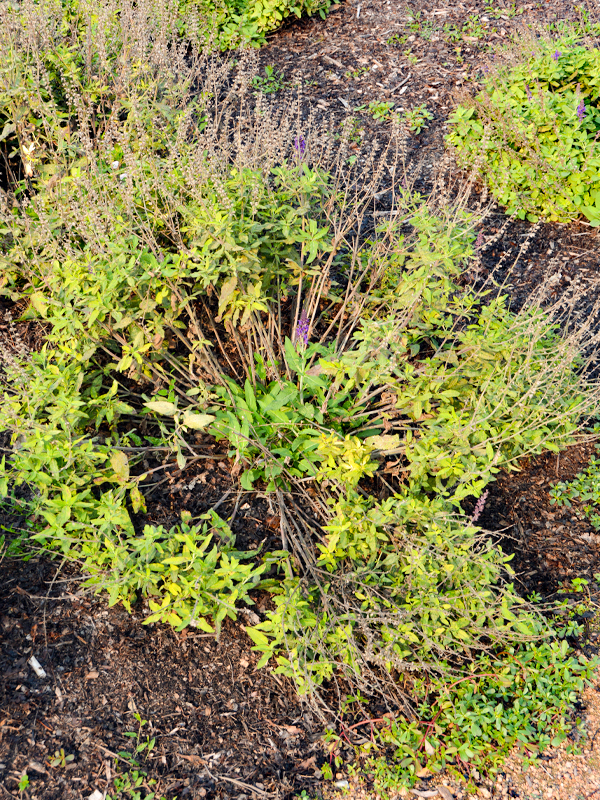
New growth of Salvia nemorosa 'Trinity' was not vigorous enough to fill the open habit.
On average, floral displays were strong, though some year-to-year variation in productivity levels were noted. Flower color fell into one of three broad categories: violet, pink, or light-colored. Of those categories, the lightcolored varieties are the easiest to further split into subcategories. While some cultivars had flowers that were nearly pure white, many of the light-colored flowers had a small amount of blue or violet pigment, resulting in a perception of an icy blue or delicate lavender color. In that category, Salvia ‘Snow Kiss’ was notable for having peach-colored buds and nearly white flowers with just a touch of pinkish pigment. While they read more as white than pink, the flowers did give an impression of a warmer white than the flowers of other light-colored varieties.
The calyx color was almost as powerful as the flower color regarding the floral displays. Flowers with darker colors stood out more when combined with an even darker calyx, as was the case with Salvia ‘Rose Marvel’ as well as the early stage of S. ‘Indiglo Girl’ (see comparison in Figure 2.), whereas light-colored flowers displayed better against a lighter or more neutral calyx, such as with S. ‘Perfect Profusion’.
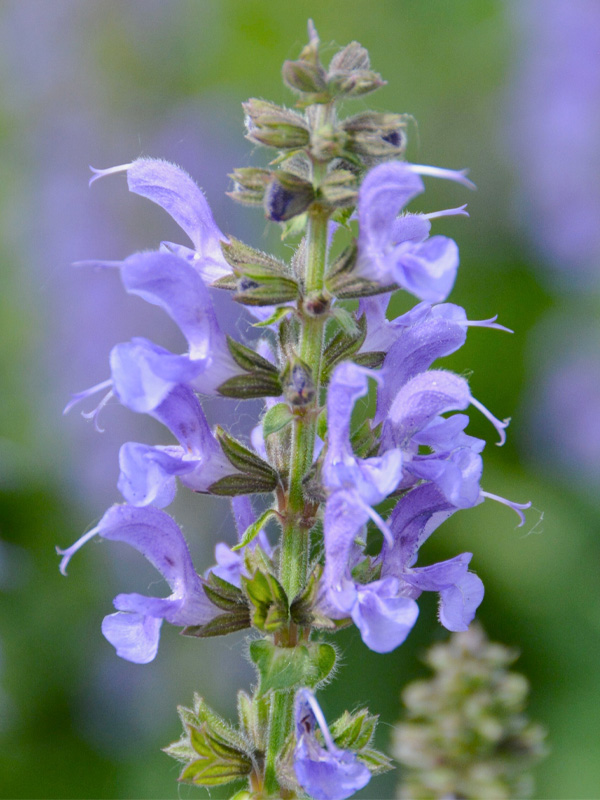
A.
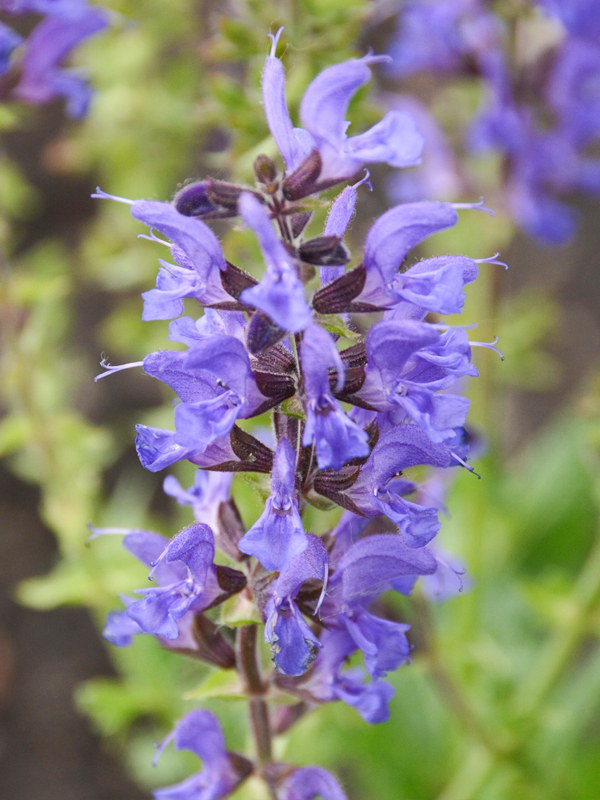
B.
Figure 2. Comparison of the effect of calyx color on perception of flower color between (a) Salvia nemorosa ‘Tidal Pool’ and (b) Salvia ‘Indiglo Girl’. Though a similar color, the flowers of ‘Indiglo Girl’ appear to be more colorful because they have both brightness and chromatic contrast against the dark calyces. With ‘Tidal Pool’, both contrasts are reduced by the lighter calyces.
The calyces of some cultivars held their color and/or transitioned to an attractive tan after the faded flowers fell away. One example of this was Salvia nemorosa ‘Blueberry Beret’, where the calyces transitioned from a dark purple to a golden brown and were noted as being quite attractive for a period of about four weeks after the initial flowers had faded (see Figure 3). In other cases, plants held their calyces, but their color transitioned to a muddier brown and they became more of a detriment to the overall display.
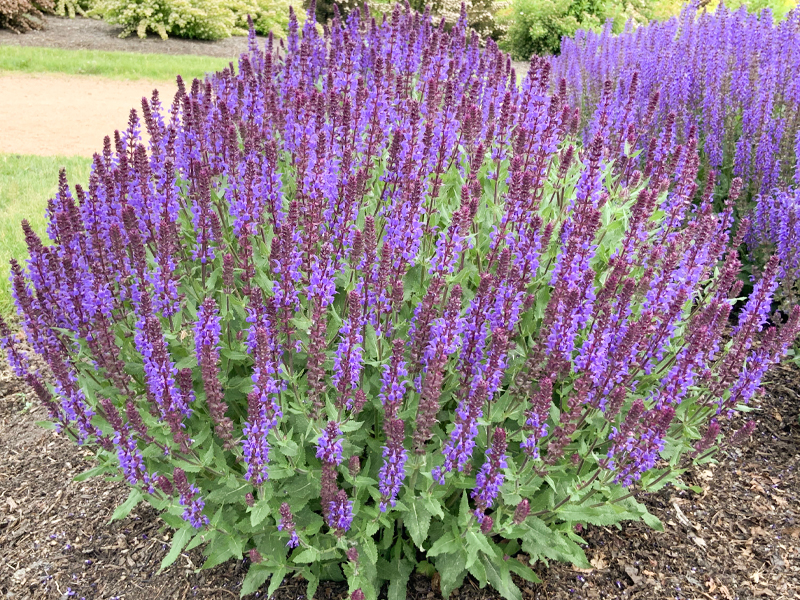
A.
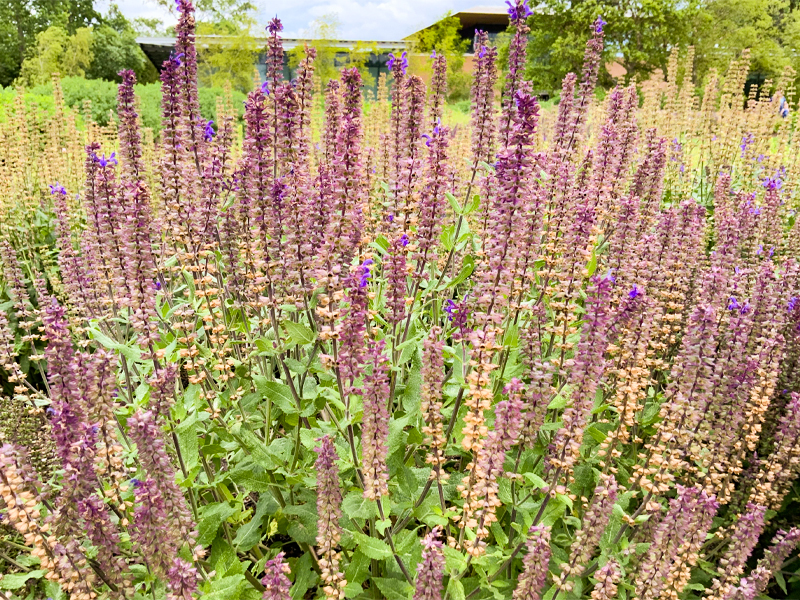
B.
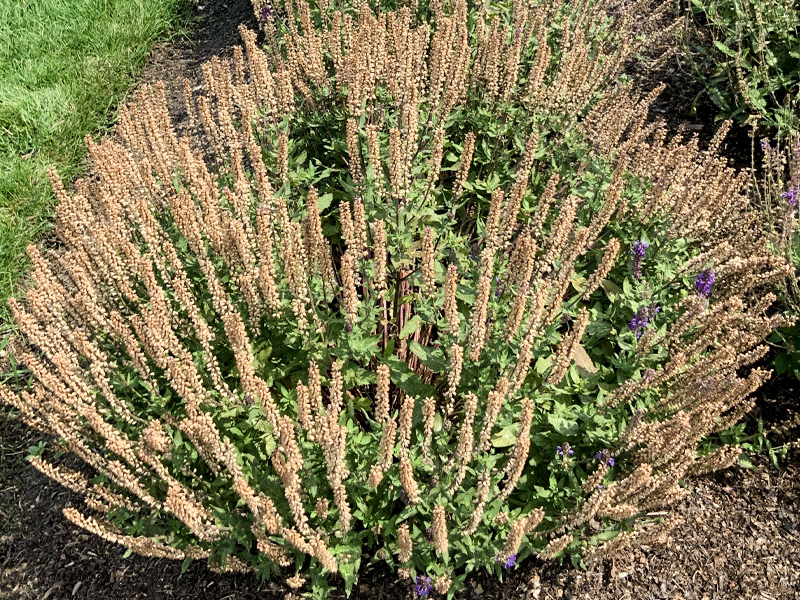
C.
Figure 3. Stages of floral aging of Salvia nemorosa 'Blueberry Beret': (a) active flowering; (b) the oldest flowers begin to drop and calyces fade starting at the bottom of the inflorescence; (c) all calyces transition to a golden brown before eventually dropping.
A significant factor in the effectiveness of the floral displays was the combination of flower size (see Figure 4) and flower color. Larger flowers tended to merge into a much bolder display, whereas smaller flowers tended to be a role player in a more textured, complex visual. Neither of these is objectively better, but having lesser variation in the visual, as was the case with larger flowers, caused gaps in flower production to appear more pronounced. A similar observation can be made about flower color. Of the available flower colors, pink has the highest hue contrast with green. For that reason, pink-flowered cultivars were some of the boldest when flower production was high, but those same flowers also attracted the eye to any inconsistencies in habit or floral display.
Some hardy salvias have much better rebloom than others. In all cases except for one, coverage of the plants in actively blooming flowers dropped dramatically after the primary bloom period. For the remainer of the growing season, active blooms never rose above 10% coverage of the plant. The only exception was Salvia ‘Fortunate Night’, which had a second bloom peak during late-summer that averaged 20% coverage. While all cultivars in the trial showed some level of continuous blooming or late summer rebloom, the level of rebloom in all cases was insignificant compared to the primary bloom period. A controlled comparison of deadheading was not performed as a part of this study. However, a previous trial of hardy salvias performed by the Chicago Botanic Garden showed that deadheading the plants did not increase stem regeneration in most cases but did enhance the perception of floriferousness by removing any obstructive elements and improving the overall health and form of the plants in the late season (Plant Evaluation Notes, no. 14).
Each spring, most of the plants emerged as tight, well-behaved mounds. Once the primary flowering period was complete, habits generally began to decline, but to varying degrees. In the best cases most stems remained upright with the occasional gap forming as the plants loosened and older growth started to fade. A more severe decline in habit involved most stems collapsing outward leaving the center of the crown exposed. The worst decline in habit was exhibited by cultivars that started opening before the end of the primary bloom. In the case of ‘Sixteen Candles’, the habit opened and revealed chlorotic inner foliage, which tended to draw the eye in and emphasize the deficiency in the habit.
Open habits were occasionally improved by later season growth that filled the vacant centers, though the degree of improvement was dependent on how deficient the habit was and the vigorousness of the new growth.
Seedlings were occasionally observed throughout the trial period, but their numbers and spread were never noted to be a concern. Infrequently, some seedlings were able to establish themselves and eventually out compete and smother some of the original trial plants. While perhaps not an ideal in most situations, some seeding is not necessarily a negative trait as it may introduce a satisfying level of variation into a planting area.
With little deviation, the overall health of the trial plants was good, especially during the initial bloom period. No recurring disease or pest issues were noted during the trial. The only observations of significant pest pressure were recorded during an outbreak of thrips in 2021. During the outbreak, all plants suffered some amount of foliar damage. Observations related to the outbreak did little to differentiate the performance of the affected cultivars, so data related to the outbreak was ultimately not factored into the final ratings.
A total of 33 plants died during winter, or about 17% of the total trial population. Out of the 40 cultivars listed in Table 1, only seven received poor ratings. Six of those seven cultivars received a poor rating due to losses during winter: Salvia ‘Ballerina Pink’, S. nemorosa ‘Blue Marvel’, S. nemorosa Lyrical™ White [‘Florsalwhite’], S. nemorosa ‘ New Dimension Rose’, S. nemorosa ‘Royal Crimson Distinction’, and S. nemorosa 'Salute Pink'. Salvia nemorosa ‘New Dimension Rose’ and S. nemorosa ‘Royal Crimson Distinction’ lost all plants during winter after only one season of active evaluation (see Table 4 for more details on winter losses).
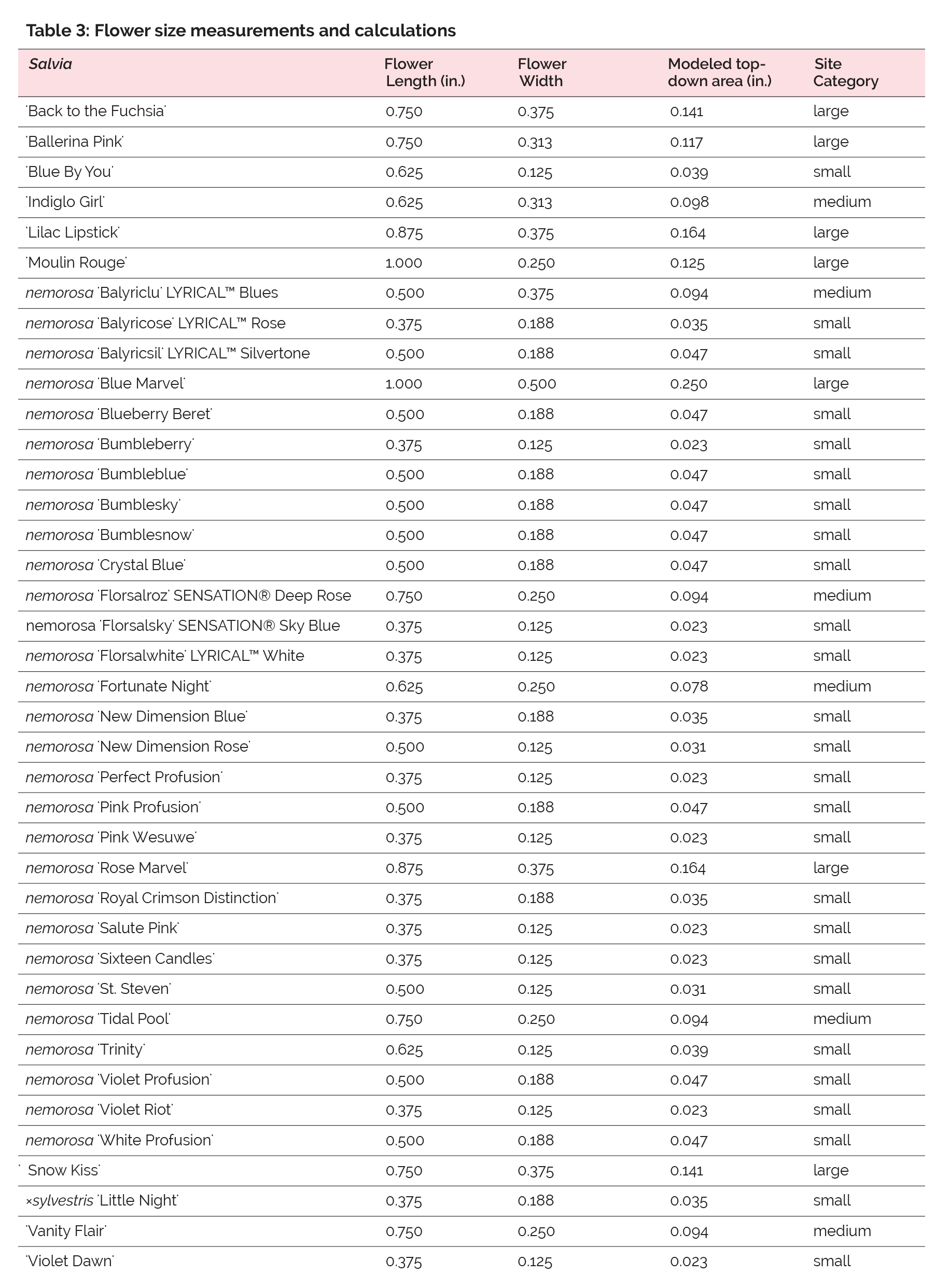
Table 3: Flower size measurements and calculations
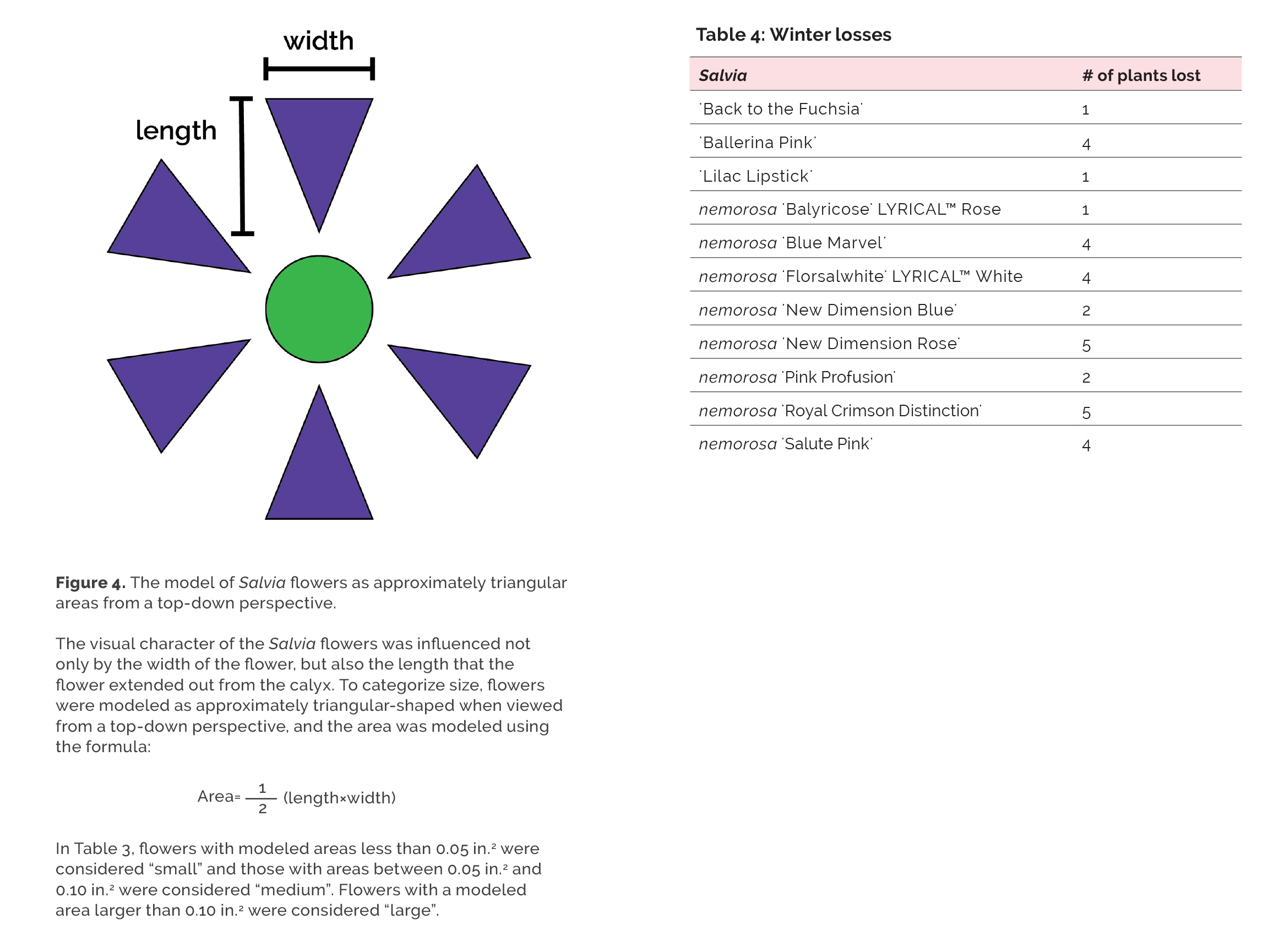
Table 4: Winter losses

Flowers of Salvia 'Snow Kiss'

Open habits of Salvia nemorosa 'Sixteen Candles' exposing lighter inner foilage.

New growth of Salvia nemorosa 'Trinity' was not vigorous enough to fill the open habit.
On average, floral displays were strong, though some year-to-year variation in productivity levels were noted. Flower color fell into one of three broad categories: violet, pink, or light-colored. Of those categories, the lightcolored varieties are the easiest to further split into subcategories. While some cultivars had flowers that were nearly pure white, many of the light-colored flowers had a small amount of blue or violet pigment, resulting in a perception of an icy blue or delicate lavender color. In that category, Salvia ‘Snow Kiss’ was notable for having peach-colored buds and nearly white flowers with just a touch of pinkish pigment. While they read more as white than pink, the flowers did give an impression of a warmer white than the flowers of other light-colored varieties.
The calyx color was almost as powerful as the flower color regarding the floral displays. Flowers with darker colors stood out more when combined with an even darker calyx, as was the case with Salvia ‘Rose Marvel’ as well as the early stage of S. ‘Indiglo Girl’ (see comparison in Figure 2.), whereas light-colored flowers displayed better against a lighter or more neutral calyx, such as with S. ‘Perfect Profusion’.

A.

B.
Figure 2. Comparison of the effect of calyx color on perception of flower color between (a) Salvia nemorosa ‘Tidal Pool’ and (b) Salvia ‘Indiglo Girl’. Though a similar color, the flowers of ‘Indiglo Girl’ appear to be more colorful because they have both brightness and chromatic contrast against the dark calyces. With ‘Tidal Pool’, both contrasts are reduced by the lighter calyces.
The calyces of some cultivars held their color and/or transitioned to an attractive tan after the faded flowers fell away. One example of this was Salvia nemorosa ‘Blueberry Beret’, where the calyces transitioned from a dark purple to a golden brown and were noted as being quite attractive for a period of about four weeks after the initial flowers had faded (see Figure 3). In other cases, plants held their calyces, but their color transitioned to a muddier brown and they became more of a detriment to the overall display.

A.

B.

C.
Figure 3. Stages of floral aging of Salvia nemorosa 'Blueberry Beret': (a) active flowering; (b) the oldest flowers begin to drop and calyces fade starting at the bottom of the inflorescence; (c) all calyces transition to a golden brown before eventually dropping.
A significant factor in the effectiveness of the floral displays was the combination of flower size (see Figure 4) and flower color. Larger flowers tended to merge into a much bolder display, whereas smaller flowers tended to be a role player in a more textured, complex visual. Neither of these is objectively better, but having lesser variation in the visual, as was the case with larger flowers, caused gaps in flower production to appear more pronounced. A similar observation can be made about flower color. Of the available flower colors, pink has the highest hue contrast with green. For that reason, pink-flowered cultivars were some of the boldest when flower production was high, but those same flowers also attracted the eye to any inconsistencies in habit or floral display.
Some hardy salvias have much better rebloom than others. In all cases except for one, coverage of the plants in actively blooming flowers dropped dramatically after the primary bloom period. For the remainer of the growing season, active blooms never rose above 10% coverage of the plant. The only exception was Salvia ‘Fortunate Night’, which had a second bloom peak during late-summer that averaged 20% coverage. While all cultivars in the trial showed some level of continuous blooming or late summer rebloom, the level of rebloom in all cases was insignificant compared to the primary bloom period. A controlled comparison of deadheading was not performed as a part of this study. However, a previous trial of hardy salvias performed by the Chicago Botanic Garden showed that deadheading the plants did not increase stem regeneration in most cases but did enhance the perception of floriferousness by removing any obstructive elements and improving the overall health and form of the plants in the late season (Plant Evaluation Notes, no. 14).
Each spring, most of the plants emerged as tight, well-behaved mounds. Once the primary flowering period was complete, habits generally began to decline, but to varying degrees. In the best cases most stems remained upright with the occasional gap forming as the plants loosened and older growth started to fade. A more severe decline in habit involved most stems collapsing outward leaving the center of the crown exposed. The worst decline in habit was exhibited by cultivars that started opening before the end of the primary bloom. In the case of ‘Sixteen Candles’, the habit opened and revealed chlorotic inner foliage, which tended to draw the eye in and emphasize the deficiency in the habit.
Open habits were occasionally improved by later season growth that filled the vacant centers, though the degree of improvement was dependent on how deficient the habit was and the vigorousness of the new growth.
Seedlings were occasionally observed throughout the trial period, but their numbers and spread were never noted to be a concern. Infrequently, some seedlings were able to establish themselves and eventually out compete and smother some of the original trial plants. While perhaps not an ideal in most situations, some seeding is not necessarily a negative trait as it may introduce a satisfying level of variation into a planting area.
With little deviation, the overall health of the trial plants was good, especially during the initial bloom period. No recurring disease or pest issues were noted during the trial. The only observations of significant pest pressure were recorded during an outbreak of thrips in 2021. During the outbreak, all plants suffered some amount of foliar damage. Observations related to the outbreak did little to differentiate the performance of the affected cultivars, so data related to the outbreak was ultimately not factored into the final ratings.
A total of 33 plants died during winter, or about 17% of the total trial population. Out of the 40 cultivars listed in Table 1, only seven received poor ratings. Six of those seven cultivars received a poor rating due to losses during winter: Salvia ‘Ballerina Pink’, S. nemorosa ‘Blue Marvel’, S. nemorosa Lyrical™ White [‘Florsalwhite’], S. nemorosa ‘ New Dimension Rose’, S. nemorosa ‘Royal Crimson Distinction’, and S. nemorosa 'Salute Pink'. Salvia nemorosa ‘New Dimension Rose’ and S. nemorosa ‘Royal Crimson Distinction’ lost all plants during winter after only one season of active evaluation (see Table 4 for more details on winter losses).

Table 3: Flower size measurements and calculations

Table 4: Winter losses
-
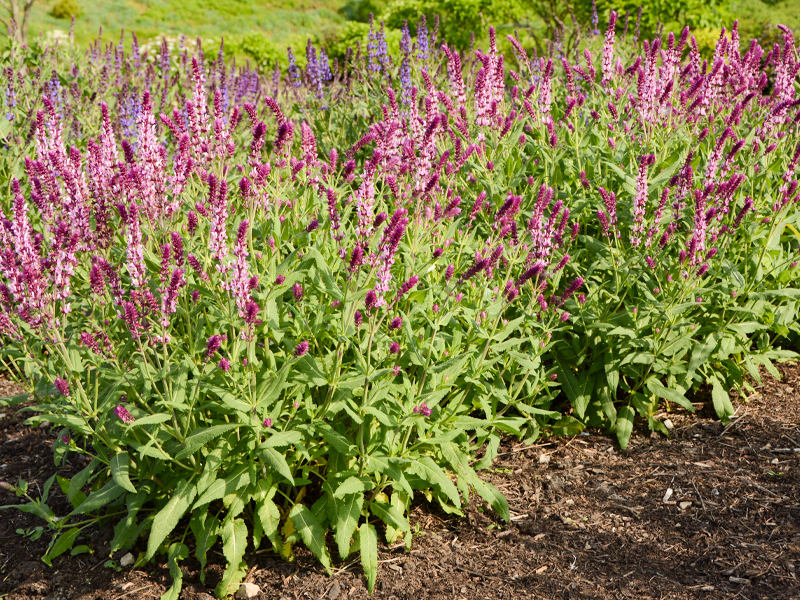
The hue of the pink flowers of Salvia nemorosa ‘Pink Wesuwe’ contrast with the green foliage more than if they were violet or a near-white color, so the gaps in flower coverage are emphasized.
Overall, the trial results show that there are many appealing cultivars of hardy Salvia to choose from, with 19 cultivars having received a good rating and seven having received an excellent rating. Health-related observations show that these Salvia cultivars are generally easy to care for and have few major health concerns. Maintenance is not required but deadheading and/or a light prune may aid in creating a tidier aesthetic in the late season. The primary concern for most gardeners will be ensuring proper drainage to support longer-term survivability. Any site that is prone to holding excessive moisture or flooding is not appropriate for these plants.
While most varieties can be expected to have some amount of rebloom, the level of rebloom is typically only a small fraction of the coverage generated by the primary bloom and expectations should be set appropriately. For that reason, the level of rebloom should not generally be considered a primary factor in selection of a cultivar for the typical gardener.
The best rated plants in the trial were those with exceptional and consistent flower coverage that did not lead to any deterioration of habit. Performance metrics were not significantly correlated with morphological characteristics such as flower color, flower size, or overall plant size, which means that gardeners should have a relatively easy time selecting good and excellent performers that also match their aesthetic preferences.

The hue of the pink flowers of Salvia nemorosa ‘Pink Wesuwe’ contrast with the green foliage more than if they were violet or a near-white color, so the gaps in flower coverage are emphasized.
Overall, the trial results show that there are many appealing cultivars of hardy Salvia to choose from, with 19 cultivars having received a good rating and seven having received an excellent rating. Health-related observations show that these Salvia cultivars are generally easy to care for and have few major health concerns. Maintenance is not required but deadheading and/or a light prune may aid in creating a tidier aesthetic in the late season. The primary concern for most gardeners will be ensuring proper drainage to support longer-term survivability. Any site that is prone to holding excessive moisture or flooding is not appropriate for these plants.
While most varieties can be expected to have some amount of rebloom, the level of rebloom is typically only a small fraction of the coverage generated by the primary bloom and expectations should be set appropriately. For that reason, the level of rebloom should not generally be considered a primary factor in selection of a cultivar for the typical gardener.
The best rated plants in the trial were those with exceptional and consistent flower coverage that did not lead to any deterioration of habit. Performance metrics were not significantly correlated with morphological characteristics such as flower color, flower size, or overall plant size, which means that gardeners should have a relatively easy time selecting good and excellent performers that also match their aesthetic preferences.

